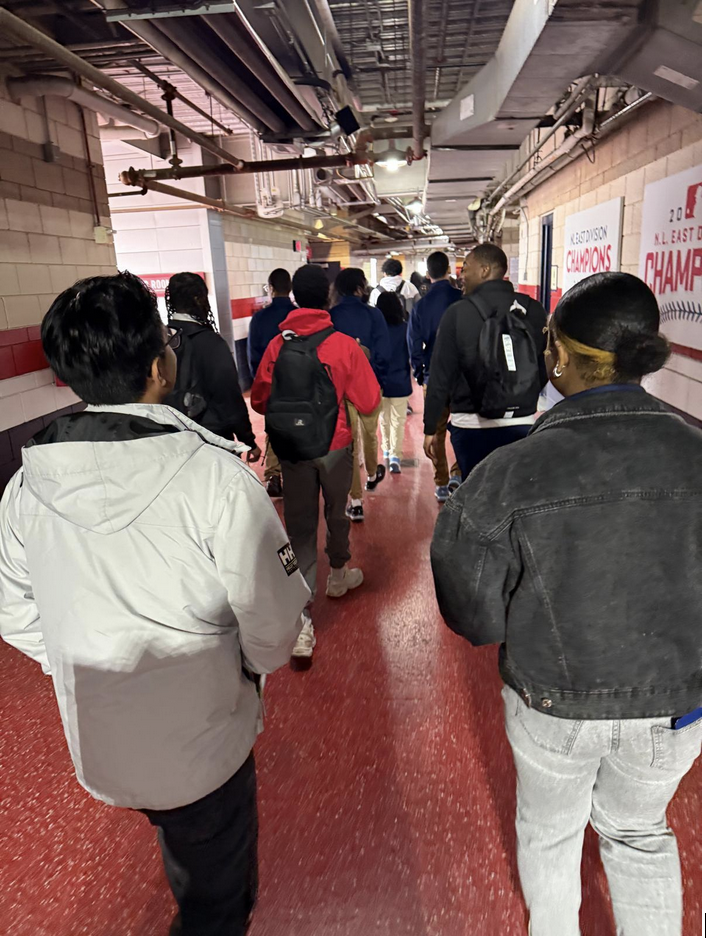
CHEC students walk to class. Photo by Ismenia Garcia.
Columbia Heights Education Campus (CHEC) is a globally themed bilingual school enrolling approximately 1,600 students in grades 6 through 12. One of the largest schools operated by District of Columbia Public Schools (DCPS), CHEC offers a wide variety of career preparation opportunities to its diverse student body. Ismenia Garcia directs four career-focused academies, or small learning communities, embedded within DCPS high schools that combine coursework, work-based learning, preparation for industry certification, and postsecondary planning. Garcia graduated from CHEC less than a decade ago and was a Spanish teacher and instructional coach there before shifting to her current role.
In this Q&A, Garcia explains how the career academies at CHEC prepare students for life beyond the classroom, with a focus on the education and childhood development academies that help students start their careers as teachers and educational aides. The conversation has been edited for length and clarity.
This Q&A is part of a series, Voices of CTE, that highlights experiences with career and technical education among DC students, educators, and program directors. We ask them to share their perspectives on how career development opportunities support students’ career pathways, to give a more personal look at the ways CTE affects students around DC. The Q&A is part of the DC Education Research Collaborative’s multiyear study to examine career development opportunities for middle and high school students in DC Public Schools.
Can you tell me a little bit about the programs that you run?
Our programs are very different depending on which one you’re looking at. Our Teacher Education academies, the first course is principles of education, and you have human growth and development, and then later on, you culminate with instructional practices. Essentially, [at first] they look at what is the history of education? Why does education exist, and how does it exist in this landscape that we’re in? Why do we have compulsory education in the United States? What are some of the things that teachers do and research to make you know [how a] class [runs]? How do you lesson plan? Why is classroom management a big deal?
Then our students get into what is developmentally appropriate for a student in middle school or for a student in high school. We do some research on that and teach them about the development of a human and what that looks like in different stages and why the activities that they develop as teachers are appropriate or why they wouldn’t be appropriate. Our students in the Child Development Academy, they’re looking at how do kids in the infant–toddler range or in the preschool age range develop motor skills.
Finally, we culminate with “work instructional practices,” just a fancy way of saying work experience. They actually get to go into the field and put these skills into practice and see how that is actually done in the classroom.
What can you tell me about the students in the program? Do they have any common interests or shared reasons for signing up for the academies?
Most of our kids are those who excel in their dual language classes. They have excelled in Spanish biology and Spanish language arts, and they are typically attracted to our education academies. We actually have a day care on campus. So those students who are interested in working [in education] may have volunteered at the day care or done their community service hours there. We also often have teen parents who are frequently excited about child development. They’re like, “Oh, well, this is real. This is about to happen to me. So let me find out more about how I can take care of my child.”
What is your favorite part of the job?
It’s amazing seeing kids receive their certification and just seeing what they can do long term. A lot of our students, they’re on track to receive their CDA [Child Development Associate] certification or their ParaPro [certification to become an educational aide].
With the ParaPro, the district supports our students becoming teachers. From high school, they can take the ParaPro practice test, and that allows them to be an educational aide right after graduation. And during that educational aide pipeline, they also get support with funding to pay for their bachelor’s degree, if that’s something that they’re interested in. It’s a way for them to get into the classroom full time and receive a degree at the same time.
So for me, it’s just cool seeing that moment when [students] finally receive something. They work so hard throughout these years, and it culminates with them receiving a certification that they can actually use for employment.
Ismenia graduated from CHEC less than a decade ago. She was previously a Spanish teacher and instructional coach at CHEC, where she became interested in supporting a pipeline for students into teaching.
At Columbia Heights, we have this history of our alums coming back and teaching at the school or serving in various capacities. We want to support and cultivate our own teachers, specifically in the dual language field, since it’s harder to find teachers qualified to teach people English, Spanish, or whatever the two languages are. I was very interested in that work and seeing how I could support the next generation of teachers. And when the position opened up, it also included hospitality and tourism, which is a field that I’m not too familiar with, but I’ve really enjoyed supporting our students in. We have great partners that make this work possible, especially in engineering and hospitality.
Interview edited by Ariella Meltzer.
The research reported here was supported by the Institute of Education Sciences, US Department of Education, through Grant R305N240059 to the Urban Institute. The opinions expressed are those of the authors and do not represent views of the Urban Institute or the US Department of Education.

